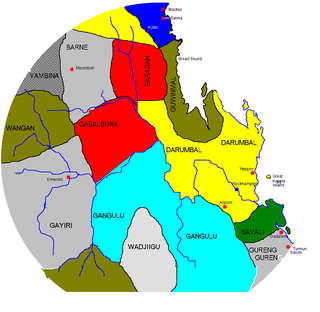The Erawirung people, also known as Yirau, Juju and other names, were an Aboriginal Australian people whose traditional territory was located in what is today the Riverland of South Australia. They consisted of sub-groups or clans, including Jeraruk, Rankbirit and Wilu, and have been referred to as Meru people, which was a larger grouping which could also include the Ngawait and Ngaiawang peoples.
The Yandruwandha, alternatively known as Jandruwanta, are an Aboriginal Australian people living in the Lakes area of South Australia, south of Cooper Creek and west of the Wangkumara people.

The Gabulbarra people, also rendered Gabalbura, Gabalbara and Kabalbara, were an Aboriginal Australian people of an area in eastern Central Queensland, but there is little recorded information about them.
The Tatungalung are an indigenous Australian people of the state of Victoria. They are often, together with the Bratauolung, Braiakaulung, Brabiralung and Krauatungalung classified as belonging to one nation, the Gunai/Kurnai, though this typology has been thought, by Norman Tindale, to be an artificial construct.
The Naualko (Nhaawuparlku) were an indigenous Australian people of New South Wales.
The Wenamba are an Aboriginal Australian people of the central eastern edge of Western Australia in the Goldfields Region.
The Warnman, also spelt Wanman, are an Aboriginal Australian people of Western Australia's Pilbara region.
The Waljen are an indigenous people of Western Australia, in the Goldfields-Esperance area.
The Kalamaia are an Aboriginal Australian people of the Wheatbelt and Goldfields-Esperance regions of Western Australia.
The Ngurlu, also known as the Ngulutjara or Ngurlutjarra, are an Aboriginal Australian people of Western Australia.
The Nangatadjara are an Aboriginal Australian people of Western Australia.
The Widi were an Aboriginal Australian people of the Mid West region of Western Australia.
The Ildawongga are an Aboriginal Australian people of the Pilbara region of Western Australia.
The Wardal were an Aboriginal Australian people of the Mid West and Goldfields-Esperance regions of Western Australia.
The Tjeraridjal are an indigenous people of the Goldfields-Esperance region of Western Australia. Horton treats them as synonymous with the Nyanganyatjara, or it may be that they speak the same dialect of the Western Desert Language.
The Kalaako (Kalarko) were an Aboriginal Australian people of the Goldfields-Esperance region of Western Australia.
The Yawarrawarrka were an in Indigenous people of South Australia.
The Bidjara people, also spelt Bitjara or Bithara, are an Aboriginal Australian people of south-western Queensland. They spoke a dialect of the Ngura language. They are not to be confused with the Warrego River Pitjara or the Badjiri of the Paroo River, both of whose traditional lands are further to the east of the state.
The Yilba, also written Ilba and Jilba, are or were an Aboriginal Australian people of the present-day state of Queensland.
The Mitaka were an indigenous Australian people of the state of Queensland.